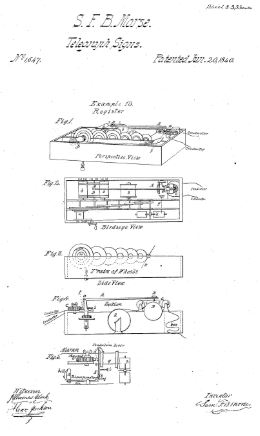On June 20, 1840, Samuel F. B. Morse was granted U.S. Patent No. 1,647A, “IMPROVEMENT IN THE MODE OF COMMUNICATING INFORMATION BY SIGNALS BY THE APPLICATION OF ELECTROMAGNETISM.” This invention later led to the creation of Morse Code.

In 1832, Samuel Finley Breese Morse began perfecting his version of an electric telegraph after he missed the death of his wife due to lag in communication. Morse’s electric telegraph consisted of eight parts:
- A circuit of electric or galvanic conductors
- A system of signs to communicate in the before-described circuit
- A set of type adapted to regulate the communication
- An apparatus called the “straight port-rule,” and another called the “ circular port-rule”
- A signal-lever
- A register which records permanently the signs communicated at any desired points in the circuit
- A dictionary that translated pulses into numbers
- Modes of laying the circuit of conductors.
Following the construction, it was apparent that a critical piece was still needed to effectively use the telegraph. A code was needed to transmit natural language using only pulses and the silence between them.
In 1836, the development of The Morse Code began with the help from inventor Alfred Vail. Eventually, Morse Code allowed operators to translate pulses and pauses into letters, words, and phrases which led to many other advancements in communication as we know today.
To learn more about the electric telegraph’s construct, you can find the full patent here.
—
